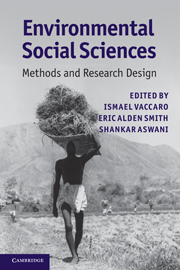Book contents
- Frontmatter
- Contents
- Contributors
- Foreword
- Preface
- 1 Introduction
- 2 People, numbers, and natural resources: demography in environmental research
- 3 Production decisions and time allocation: a guide to data collection
- 4 Analyzing the politics of natural resources: from theories of property rights to institutional analysis and beyond
- 5 Extreme events, tipping points, and vulnerability: methods in the political economy of environment
- 6 Local communities and natural resources: ethnobiology in practice
- 7 Mapping histories: cultural landscapes and walkabout methods
- 8 Metaphors and myths in news reports of an Amazonian “Lost Tribe”: society, environment and literary analysis
- 9 Water decision-makers in a desert city: text analysis and environmental social science
- 10 Linking human and natural systems: social networks, environment, and ecology
- 11 Khat commodity chains in Madagascar: multi-sited ethnography at multiple scales
- 12 Spatiotemporal methodologies in environmental anthropology: geographic information systems, remote sensing, landscape changes, and local knowledge
- 13 Deep time, diachronic change, and the integration of multi-scalar data: archaeological methods for exploring human–environment dynamics
- 14 Comparing trajectories of climate, class, and production: an historical ecology of American yeomen
- 15 Socioecological methods for designing marine conservation programs: a Solomon Islands example
- Index
- References
2 - People, numbers, and natural resources: demography in environmental research
Published online by Cambridge University Press: 05 June 2012
- Frontmatter
- Contents
- Contributors
- Foreword
- Preface
- 1 Introduction
- 2 People, numbers, and natural resources: demography in environmental research
- 3 Production decisions and time allocation: a guide to data collection
- 4 Analyzing the politics of natural resources: from theories of property rights to institutional analysis and beyond
- 5 Extreme events, tipping points, and vulnerability: methods in the political economy of environment
- 6 Local communities and natural resources: ethnobiology in practice
- 7 Mapping histories: cultural landscapes and walkabout methods
- 8 Metaphors and myths in news reports of an Amazonian “Lost Tribe”: society, environment and literary analysis
- 9 Water decision-makers in a desert city: text analysis and environmental social science
- 10 Linking human and natural systems: social networks, environment, and ecology
- 11 Khat commodity chains in Madagascar: multi-sited ethnography at multiple scales
- 12 Spatiotemporal methodologies in environmental anthropology: geographic information systems, remote sensing, landscape changes, and local knowledge
- 13 Deep time, diachronic change, and the integration of multi-scalar data: archaeological methods for exploring human–environment dynamics
- 14 Comparing trajectories of climate, class, and production: an historical ecology of American yeomen
- 15 Socioecological methods for designing marine conservation programs: a Solomon Islands example
- Index
- References
Summary
The Demographic factor in environmental anthropology
Population and demographic dynamics are characteristic traits of modern environmental anthropology. In contrast to the ambiguity of the terms used in the discipline’s earliest studies of the relations between human groups and their environment, the trend towards defining these groups as populations in the 1960s introduced a higher degree of precision into the analysis. The accuracy of ethnographic observations, the attention to the dynamics of change, and the use of a terminology derived from the natural sciences soon emerged as clear advantages of the use of the categories and models of demographic studies in anthropology (Howell 1986; Kertzer and Fricke 1997).
The issues addressed from a demographic perspective in the study of human environmental relations, as well as the terminology used in the studies, have varied greatly depending on the theoretical priorities of the moment. In this sense, most classical monographs considered demographic variables as mere data, lacking any explanatory power. In common with many other cultural and environmental variables, factors such as the size or territorial distribution of human groups were simply noted as characteristics, and no consequences were drawn for the interpretation of the issues under consideration (e.g., Forde 1934).
- Type
- Chapter
- Information
- Environmental Social SciencesMethods and Research Design, pp. 11 - 34Publisher: Cambridge University PressPrint publication year: 2010
References
- 2
- Cited by



